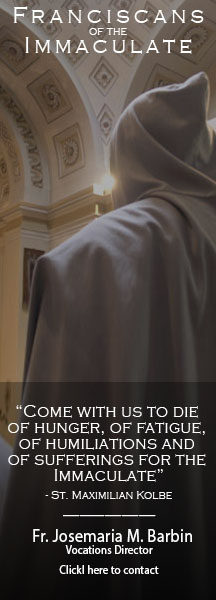Letter from St. Maximilian Kolbe to Br. Julius
Maria
Mugenzai no Sono, 2/4/1935
Dear Brother Julius,
May the Immaculate reward you for your wishing me graces, and assimilation to Her; to breathe her, and to live eternally according to her spirit; and of much toil and exhausting but fruitful labor; and much, much suffering; and heroic victories; and the sweetness of the name of Mary…
I wish all these same things to you in return, because indeed we live only once. And so we have to sell this life of ours at a dear price, or rather we must give it, offer it up selflessly.
One effort alone in Niepokalanów is essential; that is, day by day we must become evermore the property of the Immaculate. When this happens, then everything else will come to us with her. Hence, the Church applies the words of Holy Scripture to her: “All good things came to me along with her” [Wis 7:11].
O, how I desire to make this truth take root deep in the heart of everyone who breathes the air of Niepokalanów! All future development and strength depends on it. We must raise these matters in conversations among ourselves and with the new arrivals at Niepokalanów; we must penetrate them ever more deeply, holding for certain that our penetration will never be sufficient.
May the students of the minor seminary also live in the Immaculate. If they do, they will be happy, and when they are ordained to the priesthood they will be able to make others happy too.
I entrust myself to your prayers, that I might allow the Immaculate to lead me perfectly.
In Holy Father St. Francis,
Br. Maximilian Ma. Kolbe
Commentary
By Fr. Matthias M. Sasko, F.I.
Five years of hard missionary labor had elapsed for St. Maximilian and his fellow missionaries on Japanese soil when he was writing this letter. From literally nothing upon their arrival on April 24, 1930, the Franciscan mission in Nagasaki had within a month published 10,000 copies of their first number of the Mugenzai no Seibo no Kishi (the Japanese version of the Knight of the Immaculate) [1], and overcoming all sorts of difficulties, had grown by February 1935 to publishing 65.000 monthly copies [2], making it the biggest Catholic periodical in Japan [3]. Not only that – within six months of setting foot in Japan, though the friars themselves were still living in extreme poverty (at night the snow would at times get in through the cracks in the roof so that St. Maximilian would have to cover his face with his blanket in order to be able to sleep [4]), the first Catholic calendar in Japan was coming out [5].
And as that same year of the letter (1935) opened, already 1,252 members ranked among the Japanese Militia of the Immaculate [6], and only 6 months later their numbers would grow to 1,778 members [7].
In those five years the missionaries went from the initial 5 to 20, including 4 native vocations, and had a minor seminary for local youth, which within a year of its opening in 1935 counted 16 students with three lay professors [8].
And thanks to their toil, countless souls from all over the Japanese Empire as well as from the local population of Nagasaki were being drawn to Christ and to His Church – often without even seeing the missionaries themselves, but by merely seeing the benign image of Our Lady which appeared on the cover of the Knight, or by simply looking at the statue of the Immaculate, which from the rooftops of the humble Franciscan friary reigned over Nagasaki and looked maternally over the inhabitants of the city [9].
It was not only theoretically then that St. Maximilian was speaking, but from long personal experience of heroic consecration to Our Lady and of Her crushing victories over the serpent, when he commented in a Marian sense the words of the Book of Wisdom: “All good things came to me together with Her”.
We too, together with the sensus fidelium of the whole Church, know and feel that this is true. But we can and should ask ourselves: what is the theological basis of this affirmation? [10]
In his letter to the Romans, St. Paul asks: “He who did not spare his own Son but handed him over for us all, how will he not also give us everything else along with him?” (Rom 8:31). We know that with Jesus we receive all good – but where do we receive Jesus? “When the fullness of time had come, God sent his Son, born of a woman” (Gal 4:4) – Jesus comes through Mary. In Jesus we receive all good, but we receive Jesus through Mary.
This truth has been expressed by Catholic teaching by using the simple image of the neck, which connects head and body, to speak of Our Lady’s role in the Church.
“But Mary, as St. Bernard justly remarks, is the channel (Serm. de temp on the Nativ. B. V. De Aquaeductu n. 4); or, if you will, the connecting portion the function of which is to join the body to the head and to transmit to the body the influences and volitions of the head – We mean the neck. Yes, says St. Bernardine of Sienna, “she is the neck of Our Head, by which He communicates to His mystical body all spiritual gifts” (Quadrag. de Evangel. aetern. Serm. x., a. 3, c. iii.)” [11]
As St. Paul elsewhere says “He is the head of the body, the church” and “in Him all the fullness was pleased to dwell” (Col 1:18-19), and “from his fullness we have all received, grace upon grace” (Jn 1:16). But just as in any healthy body, “supported and held together by its ligaments and bonds” (Col 2:19), all communication between the head and the body passes and must pass through the neck, so in the Mystical Body.
When we become truly Hers, St. Maximilian teaches us, then all else will come to us through Mary. A little child, who alone is completely helpless, in the arms of its mother fears nothing. All it must worry about is staying near its mother, obeying its mother. And it is the mother that takes care of the rest. So it is with us and Our Lady, our Mother in the order of grace. If we stay close to Her, She will provide us with all that we need, and “all good things will come to us together with Her”, for to Her all graces and all good have been entrusted.
And from this mediation nothing is excluded, as Scripture teaches us, showing us Her mediation both in the order of grace in the Visitation (Lk 1, 39-45); and in the order of nature at Cana (Jn 2:1-12).
That is why St Bernard concludes that “God has so willed that we should receive nothing that does not pass through the hands of Mary” [12].
And this is the truth that has made the Saints. It is the truth that can make us Saints. Of this, in recent Church Magisterium, Pope Benedict XVI has reminded us, precisely on the occasion of the canonization of a new Franciscan Saint, stating that – “there is no fruit of grace in the history of salvation that does not have as its necessary instrument the mediation of Our Lady.” [13]
Footnotes
[1] – Though whole volumes could be written about this stupendous example of collaboration between human effort and grace – St. Maximilian’s own brevity works best to express at least in part the magnitude of this miracle. On May 24th, 1930, St. Maximilian briefly wrote in a telegram to Niepokalanów from Japan: “Today we are sending out the Japanese Knight. We have a printing house. Glory to the Immaculate”.
[2] – Pisma 549, 562a
[3] – SK 323a, Pisma 251
[4] – 337
[5] – 251
[6] – 549
[7] – 527
[8] – 553,586; by 1940 the number would go up to 80 students (798)
[9] – 428
[10] – Already Aristotle noted in the first lines of his Metaphysics: “All men by nature desire to know” – and since grace builds on nature, it is only right that we desire to and do in fact deepen the knowledge of our faith. St. Peter, too, admonishes us: “Always be ready to give an explanation to anyone who asks you for a reason for your hope” (1Pt 3:15).
[11] – St. Pius X, Encyclical Ad diem illum, 13
[12] – “Nihil nos Deus habere voluit, quod per Mariae manus non transiret” (In vigilia Nativitatis Domini, III 10).
[13]Holy mass and canonization of Fr. Antônio de Sant’Ana Galvão, OFM; Homily of His Holiness Benedict XVI, 11 may 2007.

